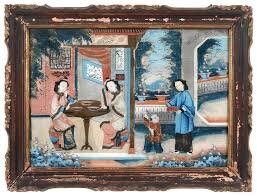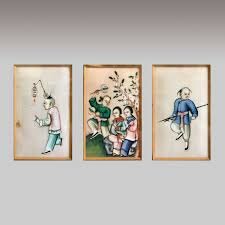Chinese art paintings have captivated audiences for centuries with their elegance, symbolism, and the profound stories they convey. Originating over 2,000 years ago, this form of art has evolved from simple strokes on cave walls to detailed masterpieces on silk and paper. Rooted deeply in Chinese culture and philosophy, these paintings continue to inspire modern artists and art lovers around the world.
The History and Evolution of Chinese Art Paintings
Chinese art painting, known as “guóhuà” (国画) in Mandarin, dates back to the Han Dynasty (206 BCE – 220 CE). In its early days, Chinese painting was heavily influenced by the cultural and religious beliefs of the time, notably Taoism and Confucianism. Over the centuries, various dynasties contributed to the development and refinement of Chinese painting styles, each adding new techniques, themes, and innovations.
The Tang Dynasty (618–907 CE), often considered a golden age for Chinese art, marked a period of vibrant creativity. During this time, painters began focusing on landscapes and nature, portraying the beauty of mountains, rivers, and rural life in breathtaking detail. Chinese painters also started to use ink wash during this period, creating a soft, natural look that became iconic in Chinese art. For more in-depth historical context on the Tang Dynasty, you can learn more on Wikipedia.
The Role of Calligraphy in Chinese Art Paintings
In Chinese art, painting and calligraphy are often intertwined, with calligraphy regarded as a critical element that complements visual storytelling. Calligraphy adds poetic verses or inscriptions to paintings, enhancing their depth and narrative. The strokes of Chinese characters echo the fluid brush movements in the painting, creating a harmonious balance. Each character’s shape, spacing, and style are crafted with the same care as the artwork itself. For artists and viewers alike, the calligraphy offers a linguistic layer to the painting, often embedding words of wisdom, philosophical musings, or personal reflections that add to the artwork’s emotional and intellectual impact.
The Influence of Chinese Art on Global Culture
Chinese art has made a significant impact beyond its borders, influencing various forms of art and culture around the world. The beauty and depth of traditional Chinese paintings have inspired Western artists, especially those interested in ink-wash techniques and symbolic representations. Movements like Impressionism and Abstract Expressionism have drawn from the principles of Chinese landscape painting, especially in their attention to mood, atmosphere, and minimalism. Today, international artists integrate elements of Shan Shui and Xieyi styles into their work, reflecting the global appreciation for the techniques and philosophies unique to Chinese art.
Key Elements and Styles in Chinese Art Paintings

Chinese art is known for its distinctive styles and techniques, some of which are unique to specific regions or dynastic periods. Here are a few of the most famous styles and methods that have defined Chinese painting:
- Shan Shui (山水) – Landscape Painting
- Shan Shui translates to “mountain water” and is a central theme in Chinese art. This style focuses on landscapes, often portraying mountains, rivers, and waterfalls in a way that reflects harmony and balance. In Shan Shui paintings, the natural elements are not just a physical backdrop; they symbolize the philosophical ideals of balance, humility, and serenity.
- Gongbi (工笔) – Meticulous Brushwork
- Gongbi is a detailed, realistic style characterized by fine lines and vibrant colors. This style is often used to depict flowers, birds, and other delicate subjects. Artists trained in Gongbi put immense effort into perfecting the lines and colors, making the paintings appear almost lifelike. This meticulous style is a testament to the skill and patience required in traditional Chinese painting.
- Xieyi (写意) – Freehand Style
- Xieyi translates to “writing the idea” and is also known as the “sketching the idea” style. Unlike the realistic approach of Gongbi, Xieyi is more expressive and abstract, aiming to capture the spirit or essence of the subject rather than its exact appearance. This style is often associated with ink-wash painting, where artists use varying shades of black ink to create depth and emotion in their work.
Symbolism in Chinese Art Paintings
One of the most fascinating aspects of Chinese art paintings is their use of symbolism. Every color, brushstroke, and subject matter is chosen with intention, often carrying deep cultural and philosophical meaning. Here are some common symbols found in Chinese paintings:
- Dragons: In Chinese culture, dragons represent power, strength, and good fortune. Unlike Western dragons, which are often seen as malevolent creatures, Chinese dragons are viewed as benevolent beings that control water and bring prosperity.
- Bamboo: Bamboo symbolizes resilience and adaptability due to its ability to bend without breaking. It is a common theme in Chinese paintings and is often paired with other plants like plum blossoms and pine trees, which together form the Three Friends of Winter – a symbol of perseverance and friendship.
- Birds and Flowers: Birds are often used to symbolize freedom and joy, while flowers represent various stages of life and seasons. For example, the peony represents wealth and honor, while the lotus signifies purity and spiritual growth.
To explore these themes further, visit Chinese Art Paintings.
Chinese Art Paintings in Interior Design
Chinese art paintings have become a popular choice for interior design, as they bring a touch of tranquility, elegance, and cultural heritage to modern spaces. Homeowners and designers alike are drawn to these artworks for their ability to create serene atmospheres that celebrate nature and simplicity. Bamboo, lotus flowers, and landscapes are particularly favored themes, as they symbolize peace and resilience. Displaying Chinese art paintings in homes, offices, and public spaces has also become a way to appreciate and honor an ancient art form that resonates deeply with people across diverse backgrounds.
Materials and Techniques
Traditional Chinese art paintings are crafted using specific materials and techniques that contribute to their unique aesthetic. Here’s a look at some of the core materials:
- Brushes: Traditional Chinese brushes are made with animal hair, giving them the flexibility needed for both precise and broad strokes. The type of brush varies depending on the style of painting – fine brushes for Gongbi and soft, broader brushes for Xieyi.
- Ink: Chinese painters often use ink sticks made from natural ingredients like pine soot. These sticks are ground on an inkstone with water to create a range of shades from pale gray to deep black.
- Paper and Silk: While silk was initially the primary medium, paper eventually became more popular due to its affordability and ease of use. Both silk and paper require a special coating to ensure the ink does not bleed and that colors remain vibrant over time.
- Colors: Although black ink dominates, traditional Chinese painters use natural pigments derived from minerals, plants, and animals. These pigments create a rich color palette that is both earthy and vibrant, enhancing the natural beauty of the subjects depicted.
Famous Artists and Their Contributions
Chinese art has been shaped by numerous influential artists, each contributing unique perspectives and styles. A few noteworthy names include:
- Gu Kaizhi: Often referred to as the father of Chinese painting, Gu Kaizhi is best known for his detailed brushwork and narrative style, which brought a new level of depth to Chinese art.
- Fan Kuan: A celebrated painter from the Song Dynasty, Fan Kuan is known for his large-scale landscape paintings that emphasize nature’s grandeur. His work “Travelers among Mountains and Streams” is a masterpiece of the Shan Shui style, symbolizing the vastness of the natural world.
- Zhang Daqian: Considered one of the greatest modern Chinese painters, Zhang Daqian mastered both traditional Chinese and Western styles. His splashed-ink technique brought a contemporary twist to classic ink-wash paintings, making his work popular worldwide.
Chinese Art Paintings in Modern Times
Today, Chinese art paintings continue to evolve as contemporary artists blend traditional techniques with modern themes. While some artists focus on preserving traditional styles, others experiment with bold colors, abstract forms, and even digital mediums. This fusion of old and new has led to a resurgence of interest in Chinese art both in China and internationally.
Chinese paintings are now showcased in major museums around the world and are increasingly popular among collectors. Art lovers can view these masterpieces online, purchase replicas, or even learn techniques from Chinese artists through workshops and courses. This growing accessibility has helped introduce a new generation to the timeless beauty of Chinese art.
Learning Chinese Painting Techniques
For those inspired by the beauty of Chinese art, learning its techniques can be an enriching experience. Art schools and cultural institutions worldwide offer classes and workshops in Chinese brush painting and ink wash painting, helping enthusiasts of all levels explore this tradition. Learning Chinese painting techniques involves not only mastering the brushstrokes but also understanding the philosophy and intention behind each stroke. As students practice these methods, they gain insight into the connection between art, mindfulness, and self-expression—a connection that makes Chinese art painting a unique journey of discovery.
Chinese Art Paintings as Cultural Heritage
Chinese art paintings are not only celebrated as individual pieces of beauty but are also recognized as a vital aspect of China’s intangible cultural heritage. The preservation and promotion of Chinese painting techniques are actively supported by Chinese museums, cultural institutions, and educational programs. Many traditional methods, such as ink grinding and silk preparation, are maintained with the same rigor as they were centuries ago, ensuring future generations can learn and appreciate these skills. Through exhibitions, cultural exchanges, and online platforms, Chinese art paintings continue to thrive, allowing a global audience to connect with one of humanity’s most enduring artistic legacies.
How to Appreciate Chinese Art Paintings
Chinese art painting is often more than meets the eye, with layers of meaning embedded in each brushstroke. Here are some tips to help you appreciate these artworks:
- Look Beyond the Surface: Chinese art often includes symbolic elements that represent concepts like harmony, resilience, and respect for nature. Understanding these symbols can enhance your appreciation of the artwork.
- Consider the Technique: Each brushstroke in a Chinese painting is deliberate and requires years of practice. Pay attention to the type of strokes, the use of color, and the balance within the composition.
- Reflect on the Themes: Chinese art often portrays philosophical themes, particularly those related to Taoism and Confucianism. Themes such as balance, humility, and the relationship between humans and nature are central to many works. By reflecting on these themes, you can gain a deeper understanding of the artist’s intent and the cultural context.
- Learn about the Artist: Knowing more about the artist’s background and the historical context of their work can provide additional insight. Many famous Chinese painters, such as Qi Baishi and Wu Guanzhong, drew inspiration from both traditional and contemporary influences.
- Explore Related Works: Each painting is part of a broader cultural and artistic tradition. Exploring works from the same era or style can give you a richer perspective on the art and how it has evolved.
Conclusion: The Enduring Legacy of Chinese Art Paintings
Chinese art paintings are more than beautiful works of art; they are a window into the culture, philosophy, and history of one of the world’s oldest civilizations. Each painting reflects the artist’s reverence for nature, respect for tradition, and understanding of balance. The enduring appeal of Chinese paintings lies in their ability to evoke emotions, tell stories, and inspire thought – qualities that make them relevant even in today’s fast-paced world.
Whether you’re an art enthusiast or a casual viewer, exploring Chinese art paintings offers a unique experience. The blend of aesthetic beauty, rich symbolism, and deep cultural meaning makes each piece a timeless treasure. For those interested in learning more about this remarkable art form, be sure to explore resources, such as Chinese Art Paintings, and continue your journey into this fascinating world.

